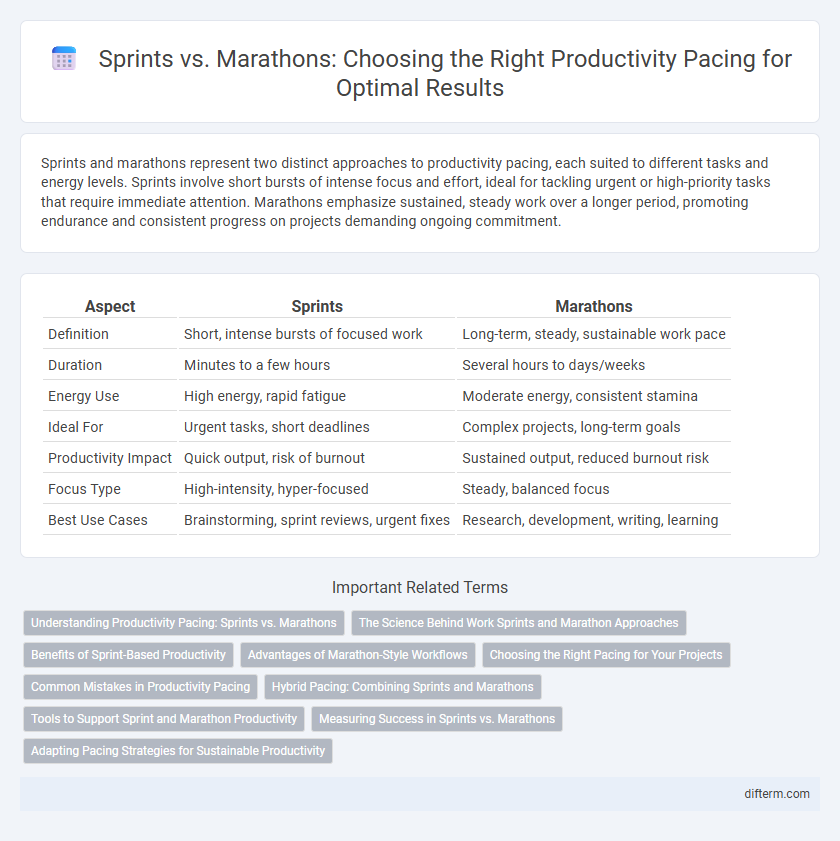Sprints and marathons represent two distinct approaches to productivity pacing, each suited to different tasks and energy levels. Sprints involve short bursts of intense focus and effort, ideal for tackling urgent or high-priority tasks that require immediate attention. Marathons emphasize sustained, steady work over a longer period, promoting endurance and consistent progress on projects demanding ongoing commitment.
Table of Comparison
| Aspect | Sprints | Marathons |
|---|---|---|
| Definition | Short, intense bursts of focused work | Long-term, steady, sustainable work pace |
| Duration | Minutes to a few hours | Several hours to days/weeks |
| Energy Use | High energy, rapid fatigue | Moderate energy, consistent stamina |
| Ideal For | Urgent tasks, short deadlines | Complex projects, long-term goals |
| Productivity Impact | Quick output, risk of burnout | Sustained output, reduced burnout risk |
| Focus Type | High-intensity, hyper-focused | Steady, balanced focus |
| Best Use Cases | Brainstorming, sprint reviews, urgent fixes | Research, development, writing, learning |
Understanding Productivity Pacing: Sprints vs. Marathons
Productivity pacing fundamentally contrasts the intense, short bursts of sprints with the steady, sustained effort of marathons. Sprints optimize focus and energy for rapid task completion, ideal for urgent projects or deadlines, while marathons emphasize long-term consistency, preventing burnout and maintaining momentum over extended periods. Understanding when to apply each pacing strategy enhances productivity by aligning work rhythms with specific goals and personal endurance.
The Science Behind Work Sprints and Marathon Approaches
Work sprints leverage the brain's peak focus cycles, typically lasting 25 to 50 minutes, to maximize short-term productivity through intense bursts of work followed by brief breaks, aligning with the Pomodoro Technique and ultradian rhythms. Marathon approaches rely on sustained, lower-intensity effort over several hours, engaging slow-twitch muscle fibers and promoting endurance, but risk cognitive fatigue and diminished returns without strategic rest. Neuroscientific studies indicate that alternating between high-intensity sprints and recovery phases optimizes dopamine release and mental energy, enhancing overall workplace efficiency and preventing burnout.
Benefits of Sprint-Based Productivity
Sprint-based productivity enhances focus and momentum by encouraging short, intense bursts of work that minimize distractions and increase task completion rates. This approach fosters quicker feedback loops, allowing for rapid adjustments and continuous improvement in workflows. Teams utilizing sprints benefit from heightened motivation and clearer goal alignment, driving efficient progress toward project milestones.
Advantages of Marathon-Style Workflows
Marathon-style workflows enhance sustained productivity by fostering deep focus through extended, consistent effort over time. This pacing reduces burnout and improves mental resilience, enabling employees to maintain high-quality output without frequent breaks. Organizations adopting marathon strategies often see better project continuity and long-term goal achievement compared to sprint-based approaches.
Choosing the Right Pacing for Your Projects
Sprints offer intense bursts of focused effort ideal for short-term projects with tight deadlines, maximizing productivity and momentum. Marathons suit long-term projects by promoting sustainable pacing, preventing burnout through consistent, steady work over time. Selecting the right pacing--sprint or marathon--depends on project scope, timeline, team capacity, and desired outcomes, ensuring optimal efficiency and resource management.
Common Mistakes in Productivity Pacing
Common mistakes in productivity pacing include overcommitting during sprints, which leads to burnout and diminished long-term output. Ignoring the need for recovery phases in marathon-style work causes mental fatigue and decreased focus over time. Failing to balance high-intensity bursts with sustainable workflows reduces overall efficiency and impedes goal achievement.
Hybrid Pacing: Combining Sprints and Marathons
Hybrid pacing in productivity merges the intense focus of sprints with the sustained endurance of marathons, optimizing energy management and task execution. By allocating high-effort bursts for critical tasks and steady efforts for long-term projects, this approach maximizes overall output and reduces burnout risk. Productivity frameworks like Agile emphasize hybrid pacing to balance rapid progress with consistent, durable performance.
Tools to Support Sprint and Marathon Productivity
Sprint productivity benefits from tools like Pomodoro timers, task managers, and time-tracking apps that facilitate intense, focused work bursts with clear deadlines. Marathon productivity relies on project management software, calendar scheduling, and wellness trackers to maintain sustained effort, prevent burnout, and organize long-term goals efficiently. Tools such as Trello, Asana, Focus Booster, and Fitbit cater specifically to optimizing both high-intensity sprints and steady, prolonged productivity marathons.
Measuring Success in Sprints vs. Marathons
Measuring success in sprints involves short-term goal completion and rapid progress tracking, emphasizing immediate outputs and quick feedback loops. In contrast, marathons require long-term performance metrics such as consistency, endurance, and sustained productivity over weeks or months. Organizations benefit from combining sprint velocity metrics with marathon endurance indicators to optimize overall productivity and project outcomes.
Adapting Pacing Strategies for Sustainable Productivity
Adapting pacing strategies by integrating sprints with marathon-like endurance fosters sustainable productivity by balancing intense bursts of focus with steady, long-term effort. Employing agile sprints allows rapid progress on critical tasks, while marathon pacing minimizes burnout through consistent energy allocation and resilience building. Combining these approaches optimizes workflow efficiency and enhances overall performance sustainability in high-demand environments.
Sprints vs Marathons (productivity pacing) Infographic

 difterm.com
difterm.com